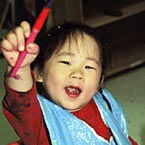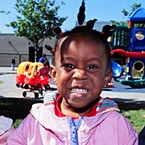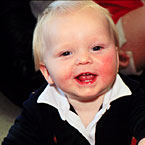


Rooms to Grow in
Their parents keep the Medical Center running while
these kids giggle and grow in the action-packed
learning environment at St. Louis Children's Hospital
Child Development Center

“Kids learn best when they're active, involved in fun and meaningful activities.”
ROSE RUDERT


Teachers try to reach the whole child through all of his or her strengths...


Keeping parents involved and informed is a top priority.


![]()
TODDLERS MAKE ART ON PAPER PLATES with pieces of colored paper and pipe cleaners, or play outside in the sprinklers, or take a ride with their friends in a big buggy. Older children build a dinosaur with boxes, or draw a wall chart of the solar system, or take a field trip to the zoo. Kids do any number of things all day long at St. Louis Children’s Hospital Child Development Center while their parents work at the School of Medicine and Barnes-Jewish and St. Louis Children’s hospitals.
“Kids learn best when they’re active,” says Rose Rudert, “involved in fun and meaningful activities.”
Rudert, who has worked at the center for 20 years, directs one of two day care facilities on the Medical Center campus. She has a special connection to the center—her daughter Blair, now 17, attended the day care center as a preschooler. At the time, Rudert was teaching kindergarten at the center. But her daughter’s attitude was, “This is my school—what are you doing here?”
It’s natural for children to feel the center belongs to them, says Rudert, because they are allowed to take the lead in planning their activities.

Traci Napier and Rose Rudert, center directors
Often, the children will choose a theme to investigate, and their teacher will devise activities based on it.Teacher Bonnie Jernigan recalls a day on the playground, when one child traced another’s shadow with chalk. “That led to a week of activities with light and shadow, the sun and the moon.”
Some themes are perennial favorites: dinosaurs, the body, outer space, the rainforest, pets. When Sue Healey’s class of 3- and 4-year-olds focused on that last theme, the children drew their pets and told stories about them while Healey took dictation. Being the children of parents in the health care profession, they naturally set up a “vet’s office.”
More than just a fun way to learn about pets, these activities lay a foundation for later success, says Rudert. Pets occupied Healey’s class for a month, but other themes might last only a few days or hours. When the children begin to lose interest, the teacher changes the subject.
“It’s the great skill of the day care worker to gauge the mood of the room,” says teacher Marcia Reed. She has 22 years of experience doing just that and currently works with infants and toddlers.
One of Reed’s favorite activities is reading. “I
love to read, even to the smallest children,” she says. Even toddlers
take in a lot, says Reed; they bring her their favorite books and are
eager for her to get to the “best” parts. She remembers with
a smile seeing one 18-month old “reading” to a classmate: holding
the book upside down, turning the pages backward and babbling.
In addition to a well-stocked library, a variety of art supplies is always
available, as are games and blocks, and each classroom contains a computer.
“The goal of the teachers is to present information in various ways,” Rudert explains. “One child might have a verbal bent, another an artistic one, while a third might take naturally to numbers. Our teachers strive to identify and work with any of these learning styles.”
But that doesn’t mean playing exclusively to a child’s strong side. If a boy draws all the time, for instance, a teacher will ask him to tell her about the picture, inviting him to say what is going on in his mind while he draws.
Teachers try to reach the whole child through all of his or her strengths, Rudert explains. That way, when children move up to kindergarten, “They go with the sense that learning is fun and the confidence that comes from having learned things already.”

Educational activities, a fun environment and opportunities
for social development are hallmarks of the St. Louis Children's Hospital
Child Development Center.
The center’s other location is run by Traci Napier, who praises her dedicated staff.
“We work very hard to provide developmentally appropriate activities and to take care of people’s kids while they’re at work,” she says.
Keeping parents informed and involved is a top priority. Notice boards in the corridors inform parents about activities and events. Children take home a slip each evening noting what they ate, how long they napped and what they did. Favorite art projects go in a binder that is taken home at the end of the year, providing parents with an overview of their child’s development.
The center also publishes a newsletter, in which Rudert, who has a master’s degree in early childhood development, writes about topics parents have suggested, such as discipline, sibling rivalry or travel with children.
Parents’ and grandparents’ days are regular entries on the school calendar, as is the annual picnic. The popular event is held on a summer evening, for the convenience of parents whose schedules don’t allow them to attend activities held during the day.
“The staff wants you to be involved, but they understand you have to work,” says Kim Donermeyer, coordinator of alumni and constituent relations at the School of Medicine and mother of two.
Joanne Nelson, a programmer analyst in the Genome Sequencing Center, also has two children at the center. She especially appreciates the room set aside for nursing mothers. “It was great that I could spend time with my baby,” she recalls. “It sure beat filling bottles.”
Donermeyer learned that the center could handle an emergency when her daughter, dehydrated after a bout of the flu, had a seizure. The staff called Donermeyer, and she arrived within minutes to find the situation under control. “The staff had called the ambulance and knew what to do for her until it arrived. The other children had been moved into another room and a teacher was explaining what had happened and keeping them calm. In a scary situation, the staff performed very well. And they called later to make sure she was all right.”
The incident did not change the way her daughter feels about the center, Donermeyer says. “She loves it. Often, when I go to pick up Erica, she says, ‘You’re here so soon! Can I play a little longer?’ If you need day care for your child, that’s the kind of place you want.”
|
BRINGING YOUR FAMILY The staff of the St. Louis Children’s Hospital Child Development Center is devoted to providing a nurturing, healthy environment for children. Traci Napier, who manages one of the center’s two locations, comments, “We have a dedicated staff that works very hard to provide developmentally appropriate activities and take the best possible care of children while their parents are at work.” The center is licensed by the State of Missouri and accredited by the National Association on the Education of Young Children. It has two facilities: 321 S. Newstead Ave. and 4353 Clayton Ave. Newstead Avenue has a capacity of 242 children and a staff of 57. Clayton Avenue has room for 226 kids along with 54 teachers. Both locations are open from 6 a.m. to 8 p.m., Monday through Friday. The two facilities are similar in layout. Each has four suites that hold eight infants and eight toddlers in separate play areas. Kitchenettes are equipped with refrigerators and microwaves so that the teachers do not have to leave the area to prepare food. Classrooms are designated for age groups 2 to 3 years, 3 to 4 years and 4 to 5 years. The Newstead facility also has a kindergarten. There are both indoor and outdoor playgrounds, and each classroom is arranged in “interest centers” for manipulatives, creative art, reading and quiet time, home living, and science and nature. All employees of Washington University in Daniel Siegel contributed to this article. St. Louis Children’s Hospital 4353 Clayton Ave. 321 S. Newstead Ave. |
![]()